في هذه الصفحة
بما أن مدونتنا السابقة تناولت أساسيات تجربة العملاءفإن هذا الدليل يشرع بوضوح في التفريق بين تجربة العملاء وخدمة العملاء، وما هي مقاييس تجربة العملاء وكيفية قياسها - إلى جانب بعض أفضل الأمثلة على تجارب العملاء في جميع أنحاء العالم لتتعلم منها.
في معجم الأعمال بأكمله، لا يكاد يوجد أي مصطلحات أخرى غير خدمة العملاء وتجربة العملاء التي تم استخدامها بالتبادل - سواء من قبل الخبراء الماهرين أو الأشخاص العاديين.
ينبع التقطع من تداخلها الشامل في وظائف بعضها البعض. لكن الحقيقة هي أن هناك خطا مختلفا بين الاثنين ، مهما كان رقيقا. ويبدأ بتعريف خدمة العملاء نفسها.
ما هي خدمة العملاء؟
كما يوحي التعريف ، تتعلق خدمة العملاء بشكل صارم بوظيفة واحدة لدعم العملاء . يكمن جوهرها في تقديم المساعدة والمشورة للعميل لمنتجك أو خدمتك حسب الحاجة قبل البيع أو بعده.
على عكس تجربة العملاء ، تعمل خدمة العملاء بشكل معزول وتتضمن أقساما تواجه العملاء ، مثل الصوت عبر IP أو الموظفين في المتاجر الفعلية.
على الرغم من أنه عادة ما ينطوي على لمسة بشرية مع العلامات التجارية ، إلا أن الانتشار السريع للذكاء الاصطناعي قد شهد ذروته في خدمة العملاء. ومن الأمثلة على ذلك الاستخدام المتزايد لروبوتات المحادثة الذكاء الاصطناعي للإجابة على الأسئلة الشائعة ومعالجة الاستفسارات الأولية.
باختصار ، خدمة العملاء هي مجرد قطعة صغيرة من اللغز تسمى رحلة العميل ، والتي تؤثر بشكل كبير على تجربة العملاء بشكل عام. وبهذا المعنى ، فهي ليست متشابكة بشكل وثيق فحسب ، بل تشترك في وجود مترابط بعمق.
لا يمكنك الحصول على تجربة عملاء مثيرة بدون خدمة عملاء قوية ، وتفقد خدمة العملاء غرضها إذا فشلت في رفع مستوى تجربة العميل. كلاهما ، بالتالي ، على نفس القدر من الأهمية.
تجربة العملاء مقابل خدمة العملاء: ما الذي يميزهم؟
بكلمات بسيطة ، خدمة العملاء ليست سوى جزء من رحلة العميل ، في حين أن تجربة العميل تنطوي على جميع التفاعلات بين العميل والعلامة التجارية.
تعد كل من تجربة العملاء وخدمة العملاء من العوامل الحيوية لنجاح المؤسسة ، ولكن من الصعب رسم خطوط بينهما. الفرق بين كيفية استخدام المستهلكين للمنتج وكيفية تواصلهم مع المستهلكين الآخرين الذين يدعمونه غير واضح.
مع ما يقال ، دعنا نتعمق في فهم كلاهما بشكل أفضل.
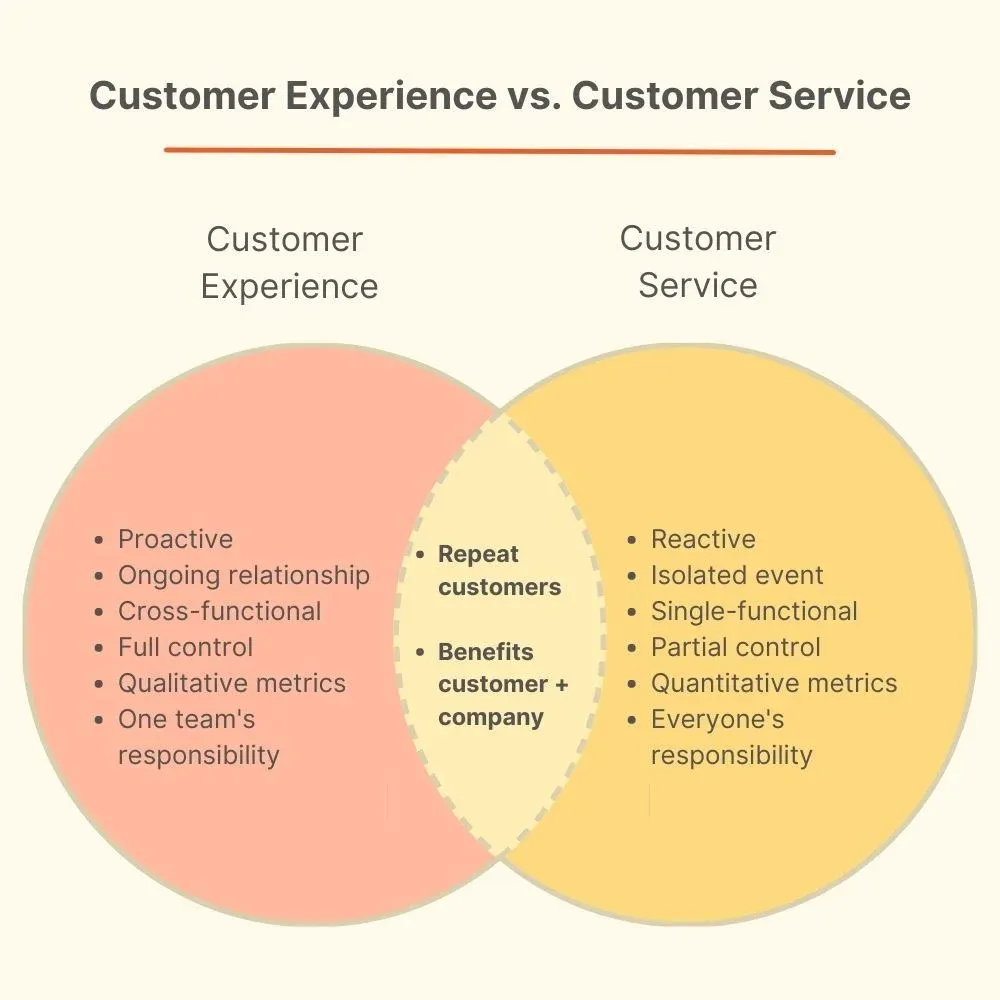
بصرف النظر عن "التفاعل المحدد بالكامل مقابل VS" الخارجي ، فإن خط الفصل يمتد طويلا وعميقا.
1. استباقي مقابل رد الفعل
- إن نفس تجربة العملاء هو توقع احتياجات وآلام العملاء ووضع الأحكام وفقا لذلك. تحاول الشركات القيام بذلك من خلال ابتكار دورة تدريجية لتجربة العملاء المحسنة من خلال رسم خرائط مفصلة لرحلة العميل ، وفهم نقاط إنزال مسار التحويل ، وجمع ملاحظات العملاء الشاملة. بهذا المعنى ، تكون تجربة العملاء المثالية استباقية دائما.
- بشكل أو بآخر ، يبدأ العميل خدمة العملاء. بعد مواجهة غير سارة مع الاحتكاك ، يتواصل العملاء مع خدمات دعم الأعمال عبر العديد من القنوات (الهاتف أو البريد الإلكتروني أو وسائل التواصل الاجتماعي أو الدردشة الحية). خدمة العملاء ، في هذا السياق ، هي رد فعل.
2. العلاقة المستمرة مقابل الحدث المعزول
- تجربة العملاء هي مقياس لجودة علاقة عميلك بعملك. لذلك لا يمكن تصنيفها في تفاعل واحد. تجربة العملاء هي علاقة مستمرة - وتنتهي فقط عندما يقرر العملاء الخروج بشكل دائم.
- ترتبط خدمة العملاء بحدث محدد ومعزول ، أي أن العميل يشكو من لوحة معلومات لا تعمل في تطبيقك. نظرا لأنه أكثر معاملات ، يتم قياسه من خلال عدد من المقاييس ، ومعدل الدقة لأول مرة ، ومتوسط وقت الاستجابة ليست سوى عدد قليل من الأسماء.
3. التحكم الكامل مقابل التحكم الجزئي
- تجربة العملاء واسعة للغاية ، وهي مزيج من جميع سبل الاتصال التي يمكن تصورها والتي لا يمكن تصورها ، والخبرات ، وتصورات العلامة التجارية ، واضطرابات السوق. نظرا لأن بعض هذه العناصر لا يمكن التنبؤ بها ، فقد تكون محروما من التحكم الصارم في مهمة نسج النسخة المثالية من تجربة العملاء المتصورة.
- يتم تصور خدمة العملاء ، بما في ذلك قناة الاتصال ومستوى التظلم ، وتنفيذها بالكامل من قبلك. يمكنك تقسيمها إلى فئات وفقا لمستوى خطورتها ، ونشر الفرق وفقا لذلك من خلال عرض مستوى تخصصها ، وتحديد عدد الاستعلامات التي تم حلها. إنه يعني إمكانية التحكم في التطواف - خاصة عند التشغيل على المستوى الأكثر كفاءة.
4. المقاييس النوعية مقابل المقاييس الكمية
- تجربة العملاء هي كيان تجريبي وعاطفي جوهري. ومع ذلك ، هناك مقاييس معينة مثل القيمة الدائمة للعميل (CLV) ، ومعدل زبد العملاء ، ومعدل الاحتفاظ بالعملاء ، والتي يمكن أن تكون مؤشرا قويا على جودتها.
- نظرا لأن خدمة العملاء تفاعلية ، فمن السهل نسبيا قياس مدى سرعة وانتظام استجابتك ، وعدد الاستفسارات التي قمت بحلها ، ومستوى رضا العملاء بعد كل تفاعل. وبالتالي ، فإن درجة رضا العملاء (CSAT) ، ودرجة جهد العملاء (CES) ، وصافي نقاط الترويج (NPS) هي مؤشرات رئيسية لجودة خدمة العملاء.
5. مسؤولية فريق واحد مقابل مسؤولية الجميع
- تجربة العملاء هي ما يفكر فيه العميل ويشعر به ويتذكره ويتحدث عنه عن شركتك. مع وجود المئات من نقاط الاتصال التي تسهل التفاعل مع شركتك ، وهذا أيضا على مستويات متعددة ، فإن الحفاظ على تجربة عملاء جديرة هي مسؤولية الجميع في المؤسسة ، بدءا من فريق المنتج إلى موظفي التوصيل.
- تقع مسؤولية خدمة العملاء بشكل أساسي على عاتق فريق دعم العملاء. قد تتفاعل الفرق الأخرى مع العملاء لمختلف الإكراهات الإجرائية. لكن فريق دعم العملاء هو المسؤول عن مساعدة العملاء في أوقات الشدة.
كيف تقيس تجربة العملاء بدقة؟
على الرغم من الاتفاق مع ما يقوله إد طومسون ، فإن قياس تجربة العملاء موضوع محفوف بالتحديات. إنه أمر مفهوم لأنه يتضمن نقاط اتصال متعددة ، ويجتاز قنوات مختلفة بأهداف مختلفة. بطبيعة الحال ، يصبح من الصعب معرفة ما الذي ينجح وما لا ينجح.
يذكر نيلسن أن النتائج القابلة للقياس قد تكون مؤشرات جيدة لمعرفة حيوية تجربة العملاء. لكن هذا البحث نفسه وجد أيضا أن 80٪ من مصممي تجربة العملاء لا يستخدمون المقاييس.
لماذا هذا التناقض؟ يرجع ذلك عموما إلى أن إضافة مقاييس إلى رحلة العميل الطويلة والمعقدة تضيف تعقيدا إلى مهمة صعبة بالفعل. الحل ، إذن ، هو نموذج من ثلاث خطوات لجمع المقاييس لرحلة عميلك.
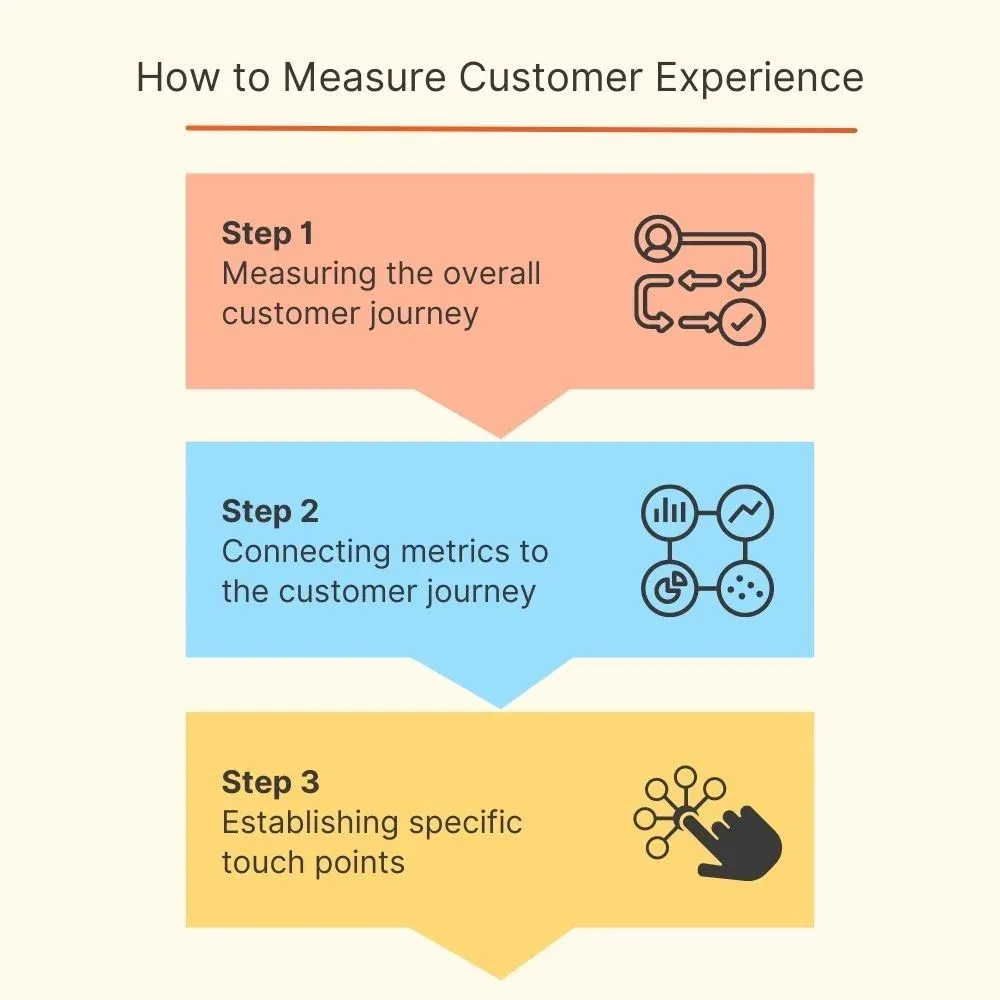
الخطوة 1: قياس رحلة العميل الإجمالية
نظرا لأن القياس العام يعطي صورة كاملة عن الكفاءة ، فإن هذه المرحلة والمقياس سيكونان مقياسك النهائي لنجاح تجربة العملاء.
بعد استطلاع رأي 27,000 مستهلك, ماكنزي أن قياس الرحلة الإجمالية كان مؤشراً أفضل بكثير لتجربة فعّالة من قياس نقاط الاتصال.
وكما أشارت: أداء الشركة في الرحلات هو 35٪ أكثر تنبؤا برضا العملاء و 32٪ أكثر تنبؤا باضطراب العملاء من الأداء على نقاط الاتصال الفردية.
تشمل المقاييس الأكثر استخداما لقياس تجربة العملاء الإجمالية ما يلي:
- صافي نقاط الترويج (NPS)
- نقاط جهد العميل (CES)
- رضا العملاء (CSAT)
دعونا نفهم بشرتهم.
1. صافي نقاط الترويج (NPS)
NPS هو معيار يقيس ولاء العملاء ورضاهم وحماسهم مع الشركة من خلال طرح سؤال واحد على العملاء: "على مقياس من 0 إلى 10 ، ما مدى احتمالية أن توصي بهذا المنتج / الشركة لصديق أو زميل؟"
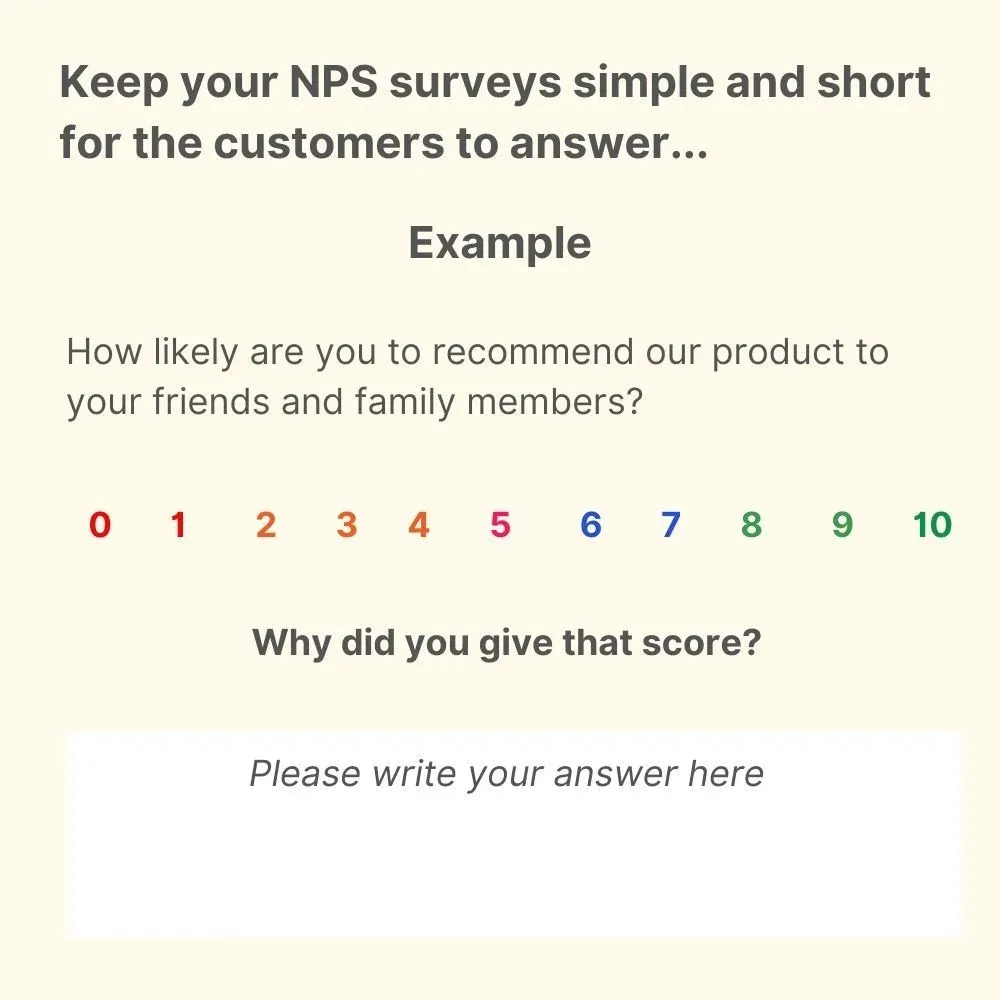
تمنحك NPS ، بشكل عام ، رقما متعلقا بتجربة العملاء تحتاجه لتحسين الخدمات وأنظمة الدعم ومعالجات ما بعد البيع. يستخدم NPS على نطاق واسع لتقييم علامة تجارية أو خدمة أو منتج.
كيف تحسب NPS؟
- احسب النسبة المئوية للمروجين من عملائك الذين شملهم الاستطلاع.
- احسب النسبة المئوية للمنتقدين.
- اطرح النسبة المئوية للانتقاص من النسبة المئوية للمروج.
لماذا NPS مهم؟
على الرغم من أن NPS يشير إلى حد ما إلى جودة العلاقة التي تربطك بعملائك ، إلا أنه لا يوجد رقم وحده ، بشكل عام ، يكفي لرسم صورة كاملة لتجربة العملاء الخاصة بك. يعد نظام NPS ككل أمرا بالغ الأهمية لأنه يسمح للشركات:
- تعمق في أسئلة المتابعة كجزء من استطلاع NPS. من خلال سؤال العملاء عن الأساس المنطقي وراء النتيجة المحددة التي يقدمونها للمؤسسات ، يمكن للمؤسسات تحديد مجالات التحسين بدقة.
- راقب جودة وكمية الدرجات بمرور الوقت ، مما يساعد في وضع معايير داخلية.
- غرس جميع الموظفين بمهمة واحدة: كسب المزيد من العملاء والاحتفاظ بهم من خلال تجربة وخدمة العملاء المثالية.
2. رضا العملاء (CSAT)
يشير CSAT إلى ما يعبر عنه على القصدير: فهو يقيس مستوى رضا العملاء عن عملك. واحدة من أكثر الطرق المباشرة لقياس الرضا ، يمكن أن تأخذ في الاعتبار نقطة اتصال معينة على طول رحلة العميل أو مع علامتك التجارية ككل.
يعتمد CSAT على سؤال واحد يشير إلى مدى قربك من تلبية توقعات عملائك ، مثل:
كيف تقيم رضاك العام عن المنتج (المنتجات) / الخدمة (الخدمات) التي تلقيتها من الشركة X؟
- غير راض جدا
- غير الملباه
- محايد
- قنع
- راض جدا
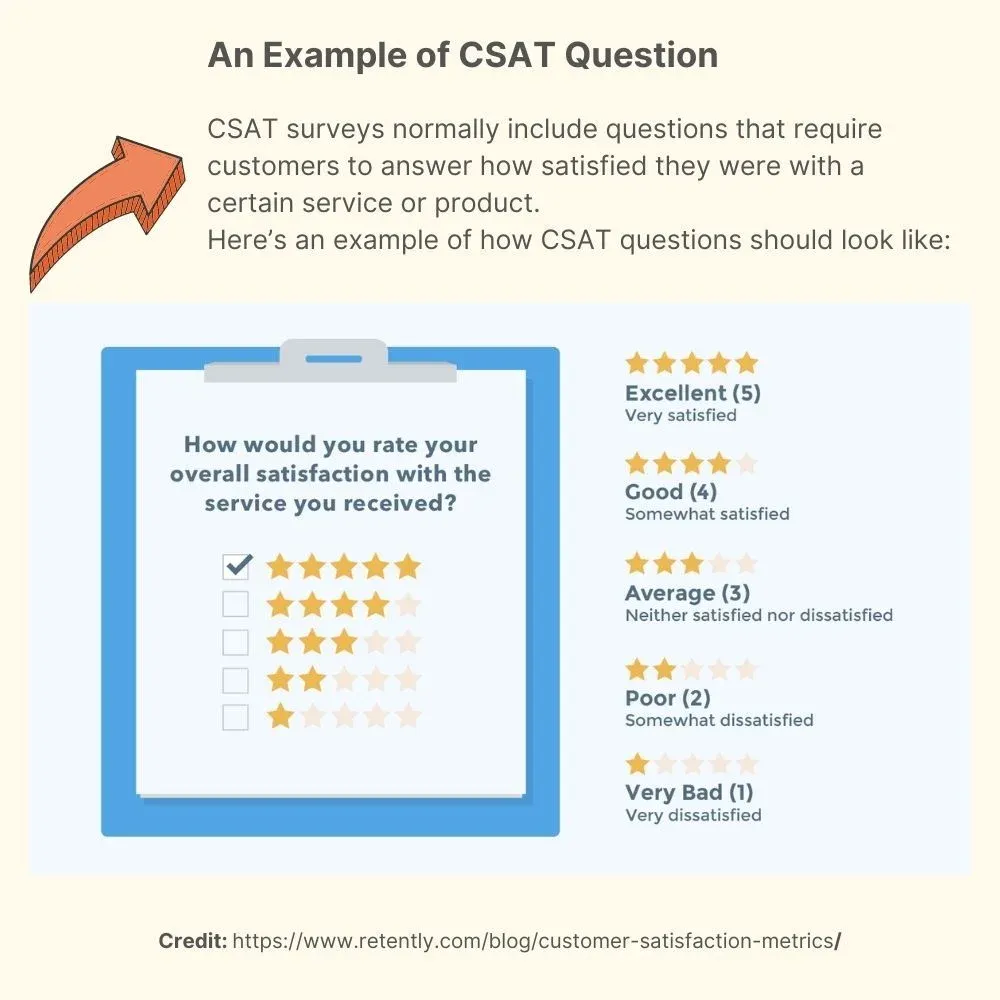
لاحظ أن استطلاعات CSAT لا تقتصر دائما على سؤال واحد. يمكنك تخصيص العديد من الأسئلة المفتوحة والمغلقة في نفس الاستطلاع لتناسب احتياجاتك - كما تفعل سلسلة فنادق هيلتون.
كيف تحسب CSAT؟
تحدد CSAT بشكل فردي النسبة المئوية للعملاء السعداء. أثناء إجراء هذا الحساب ، يتم تضمين الردود "راض جدا" و "راض" فقط. يجب عليك قسمة عدد العملاء الراضين على إجمالي عدد الردود على الاستطلاع وضرب هذا الرقم في 100.
لماذا CSAT مهم؟
تأتي المصادقة الحقيقية لتجربة العملاء الرائعة من رضا العملاء الحقيقي ، وينسج الرضا سحرا دائما - تؤدي زيادة بنسبة 10٪ فقط في درجة CSAT للشركة إلى زيادة بنسبة 12٪ في ثقة العملاء.
أثبتت الأبحاث أن تعزيز الرضا طوال رحلة العميل يؤثر بشكل إيجابي على رضا العملاء بنسبة 20٪ ، ويعزز الإيرادات بنسبة تصل إلى 15٪ ، ويخفض تكلفة خدمة العملاء بنسبة 20٪.
علاوة على ذلك ، تقدم طريقة CSAT مزايا أخرى:
- إنه قصير وتفاعلي وسهل الاستخدام.
- يمكن تخصيص مقياس التصنيف وأنواعه وفقا للسياق ، مما يسمح لك باستخدام النجوم أو الرموز التعبيرية أو مقاييس التصنيف الرقمية التي تتوافق مع علامتك التجارية العامة.
- نظرا لأنه لا يستهلك الكثير من الوقت والاهتمام من العملاء بسبب قلة الأسئلة ، يضمن CSAT معدلات استجابة أعلى من معاصريه.
3. نقاط جهد العميل (CES)
درجة جهد العميل (CES) هي مقياس يقيس الجهود التي يبذلها العملاء لبدء التفاعلات مع عملك.
تتضمن هذه التفاعلات الجهود التي يبذلها العملاء لاستخدام منتجك ، ومدى سهولة العثور على المعلومات ذات الصلة على موقع الويب الخاص بك ، ومدى سهولة حل المشكلة بواسطة ممثلي الخدمة.
باختصار ، بدلا من قياس تجربة العملاء الإجمالية ، يقيس CES سهولة تفاعل العملاء وتجربتهم من خلال طرح أسئلة تشغيلية ووظيفية بسيطة مثل:
كيف تحسب CES؟
يتم حساب CES بقسمة إجمالي درجات جهد العملاء على إجمالي عدد الردود على الاستطلاع. يمنحك متوسط الجهد الذي يبذله عملاؤك أثناء التفاعل مع عملك.
الهدف من مقياس CSAT ، إذن ، هو إعطائك رؤى محددة وقابلة للتنفيذ حول المجالات التي تحتاج إلى تحسين جذري. إذا كانت تقاريرك تشير إلى أن العملاء يبذلون الكثير من الجهد لرفع تذكرة شكوى ، فأنت تعرف مكان المرض وما يجب القيام به.
لماذا يعتبر CES مهما؟
بشكل افتراضي ، الإنسان محب للمتعة. في اللحظة التي يواجه فيها منحنى عالي التعلم أو احتكاكا مرهقا في مهمة ما ، يستهلكه الشعور القوي بمقته.
كانت حقيقة الطبيعة البشرية هذه في صميم مقال هارفارد بزنس ريفيو بعنوان توقف عن محاولة إسعاد عملائك ، والذي من المفترض أنه أدى إلى زيادة شعبية CES كمقياس.
كانت النتائج التي توصلت إليها غير عادية في ذلك الوقت: الطريقة البسيطة لزيادة ولاء العملاء ليست من خلال إبهار عملائك - ولكن من خلال تسهيل قيامهم بما يريدون القيام به.
لخص المقال هذا التعلم بقوله:
"عندما يتعلق الأمر بالخدمة ، تخلق الشركات عملاء مخلصين في المقام الأول من خلال مساعدتهم على حل مشاكلهم بسرعة وسهولة."
الحكم: ما هو أفضل مقياس يقيس تجربة العملاء بشكل عام؟
إنها مسألة نقاش ، حيث وضع العديد من الخبراء ثقلهم وراء مقاييس مختلفة.
تعتقد Gartner أن CES يتفوق على NPS و CSAT في التنبؤ بإعادة شراء العملاء وزيادة الإنفاق ، كما يوضح الرسم البياني التالي.
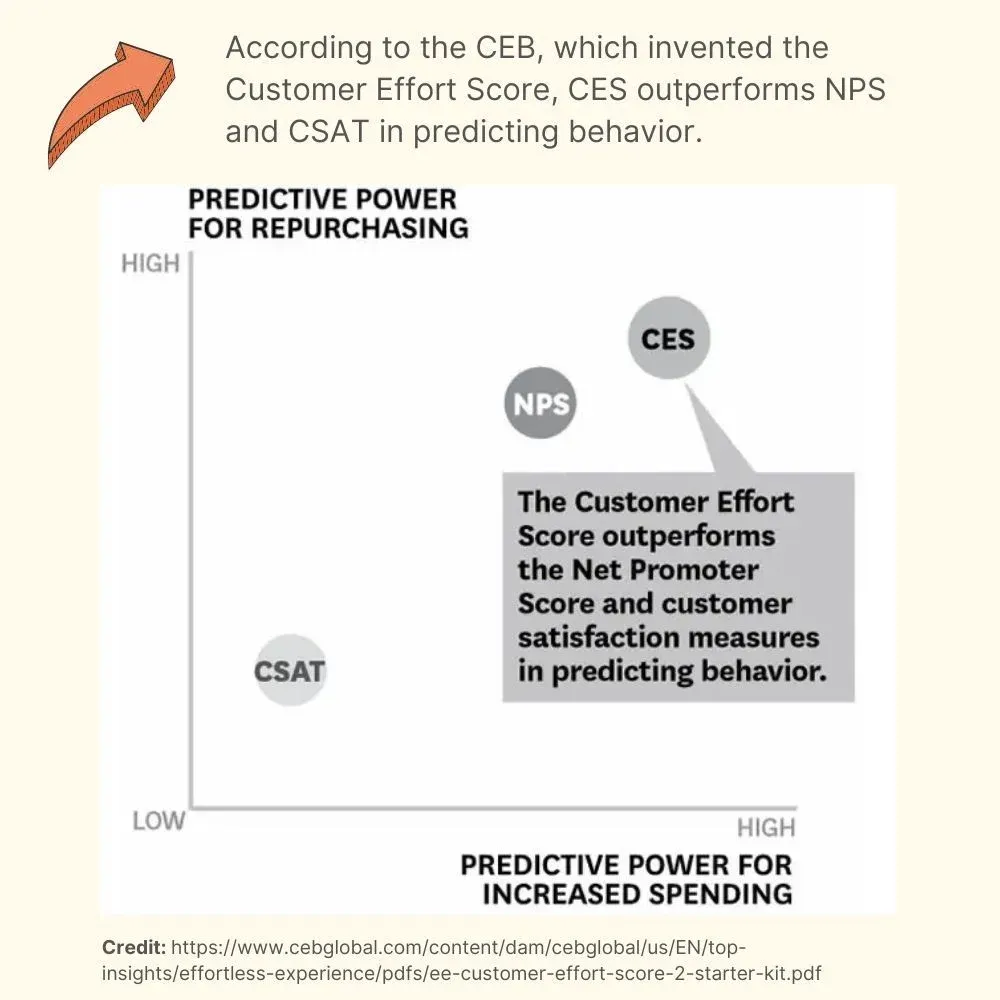
من ناحية أخرى ، تصف ماكينزي أهمية رضا العملاء (CSAT): إن تحقيق أقصى قدر من الرضا عن رحلات العملاء لديه القدرة ليس فقط على زيادة رضا العملاء بنسبة 20٪ ولكن أيضا لزيادة الإيرادات بنسبة تصل إلى 15٪.
من الواضح أن جميع المقاييس تهب ساخنة وباردة على مؤشرات رئيسية مختلفة. لذلك ، ينصح بتتبعها جميعا للحصول على صورة كاملة عن فعالية تجربة العملاء الخاصة بك.
الخطوة 2: ربط المقاييس برحلة العميل
نظرا لأن رحلات العملاء تختلف باختلاف المنتجات ومراحل الشراء المختلفة ، فإن المقاييس المستخدمة لقياس فعالية كل مرحلة تختلف أيضا. السؤال الحاسم إذن هو: هل تؤدي كل مرحلة من مراحل رحلتنا هدفها الرئيسي؟
وعي:
- السؤال الرئيسي: هل يعرف العملاء علامتك التجارية ومنتجاتك وميزات المنتج؟
- المقاييس التي يجب قياسها: حصة Voice في السوق ، إجمالي الزيارات إلى موقع الويب الخاص بك
نظر:
- السؤال الرئيسي: عندما يقرر العملاء الشراء ، هل يفكرون فيك؟
- مقاييس للقياس: حركة مرور الكلمات الرئيسية العضوية التي تدور حول منتجك ، وإقبال متجر البيع بالتجزئة
ابتاع:
- السؤال الرئيسي: بمجرد أن يبدأ العملاء في عملية الشراء ، هل يكملون عمليات الشراء؟
- المقاييس التي يجب قياسها: معدلات السلة/سلة التسوق المهجورة، الإقبال على المتاجر مقابل المشتريات
احتباس:
- السؤال الرئيسي: هل سيعود العملاء الحاليون للتسوق معك مرة أخرى؟
- المقاييس المراد قياسها: القيمة الدائمة للعميل (CLV) ، معدل الشراء المتكرر ، قيمة الطلب ، حجم تذكرة خدمة العملاء
الدعوه:
- السؤال الرئيسي: هل عملاؤك مستعدون للتوصية بك للآخرين؟
- مقاييس القياس: صافي نقاط الترويج (NPS) ، المشاعر على وسائل التواصل الاجتماعي ، أرقام الإحالة.
الخطوة 3: إنشاء مقاييس محددة لنقاط الاتصال
السؤال الحاسم في هذه الخطوة هو: "هل تزيل نقاط الاتصال الخاصة بك الاحتكاك وتجعل العملاء سعداء؟"
أمثلة على مقاييس نقطة الاتصال المادية:
- متجر البيع بالتجزئة: إجمالي الإقبال مقابل العدد الفعلي للمشتريات ، وحجم سلة التسوق ، والمبيعات في البيع بالتجزئة ، وعدد الاستعلامات.
- اتصالات نقاط الشراء بالتجزئة (POP): رفع مبيعات المنتجات ، وارتفاع المبيعات بشكل عام ، وتأثير الهالة على المبيعات
أمثلة على مقاييس نقاط الاتصال الرقمية:
- موقع التجارة الإلكترونية: الجهوزية ، إجمالي نقاط الإنزال ، معدل الارتداد ، سرعة التحميل ، أداء صفحة الجوال ، وقت الإقامة.
- دعم الدردشة عبر الإنترنت: مدة دردشة الدعم ، رضا العملاء بعد دردشة الدعم ، تكرار الشراء ، وقت الانتظار ، مشاعر العملاء في الدردشات
لاحظ أن جميع مقاييس نقطة الاتصال ليس لها تأثير متساو على تجربة العميل بشكل عام. قد تحتاج بعض نقاط الاتصال، مثل الملصقات، إلى مقياس واحد لمعرفة ما إذا كانت تعمل أم لا. قد تتطلب بعض نقاط الاتصال المهمة ، مثل مواقع الويب ، أكثر من مقياس واحد.
وبالتالي ، فإن معرفة نقاط الاتصال الأكثر أهمية وكيف تؤثر على تجربة العملاء أمر ذو أهمية حيوية. يمكن أن تكون قاعدة نهاية الذروة ضوءا إرشاديا في هذا السياق.
قاعدة نهاية الذروة: مبدأ العلوم السلوكية الذي يمكن أن يحول تجربة العملاء الخاصة بك.
تؤكد قاعدة نهاية الذروة أن الناس يحكمون أخيرا على التجربة بناء على شعورهم في ذروتها ونهايتها بدلا من متوسط كل لحظة من التجربة. سواء كانت التجربة جيدة أو سيئة ، فإن هذا صحيح.
إنه يعني بشكل لا لبس فيه أن العملاء سيتذكرون تجربتهم الكاملة مع علامة تجارية بناء على لحظتين فقط: أفضل أو أسوأ جزء من التجربة والنهاية.
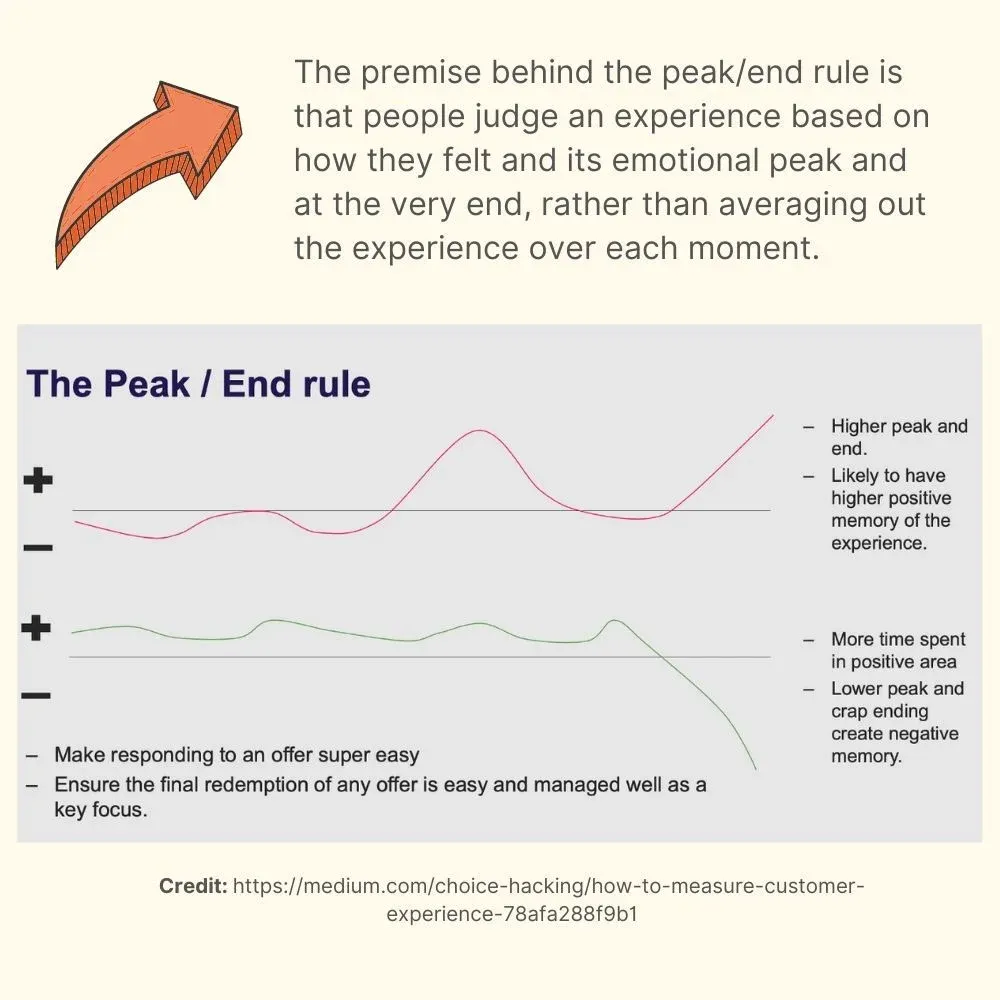
تحذير: بدون السياق، لا تعني المقاييس شيئا
بالنظر إلى مدى تعرض الأرقام لسوء التفسير ، يمكن أن تكون المقاييس خادعة للغاية. إذا كان عليها أن تكون منطقية ، فيجب تركيبها في السياق الصحيح. يعد قضاء وقت الإقامة على موقع الويب مثالا كلاسيكيا على هذا التفسير الخاطئ.
من السهل تصديق أن وقت الإقامة يعني أن العملاء يستمتعون بتجربة موقع الويب الخاص بك وهم مدمنون عليها بسرور. ومع ذلك ، في الواقع ، قد يكونون جاهلين بشأن التنقل في موقع الويب الخاص بك ويشعرون وكأنهم يضيعون في كهف.
الحل الوحيد هو غرس التدقيق النوعي مثل الدراسات القائمة على الملاحظة في البيانات الكمية لفهم "لماذا" وراء كل "ماذا".
أمثلة على تجربة العملاء الجيدة
الآن مجهزة بالمعنى الفعلي لتجارب العملاء ، والمقاييس الصحيحة لقياسها ، والدليل القاطع على سبب أهميتها ، فإن الامتداد المنطقي التالي هو التقليب الجاد للأمثلة التي جسدت تجربة العميل كما لم يحدث من قبل والتعلم منها.
سيكون هذا الصب الثابت للتعلم بمثابة دليل يتحدث عن مساعيك لصياغة تجربة عملاء لا تنسى. بعد كل شيء ، لا يمكن تدريس كل شيء ، ولكن يمكن تعلم كل شيء.
1. JetBlue: عندما أصبحت صغيرة مثل القهوة أداة كبيرة لرضا العملاء
عندما كان بول براون يطير عبر خطوط جيت بلو الجوية ، وأدرك مدمن القهوة المتشددين فيه أنه من الصعب تناول قهوة ستاربكس قبل ركوب الطائرة بسبب المحطة الأصغر ، قام بالتغريد عرضا حول هذا الموضوع.
في غضون دقائق من التغريدة ، قفز JetBlue إلى العمل ، وسلم ممثل خدمة العملاء في المطار ستاربكس فينتي موكا اللذيذ والكريمي إلى مقعده على متن الطائرة.
ناهيك عن أن براون كان أكثر من مبتهج - ليس لأنه تمكن أخيرا من احتساء قهوته المفضلة. ولكن لأن التجربة جاءت عندما لم يكن متوقعا.
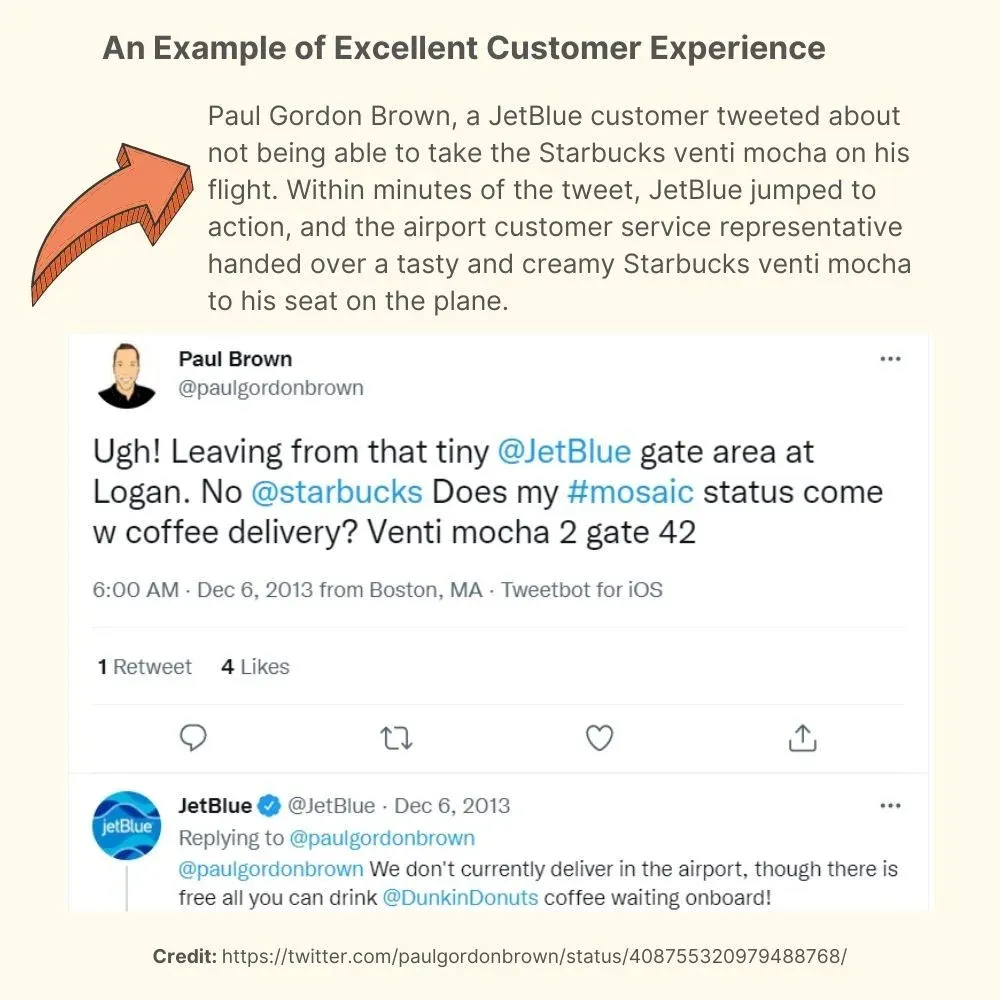
📚 مفتاح التعلم: هذا المثال بالذات يتوافق إلى حد كبير مع مقال هارفارد بزنس ريفيو الذي ناقشناه سابقا. أفضل طريقة لإرضاء العملاء وكسب الولاء هي مساعدتهم عندما يكونون في محنة أو يواجهون مشكلة ، مهما كانت هذه المشاكل صغيرة.
أولا وقبل كل شيء ، يضمن مستوى تقديرك وقيمتك للعميل - نقطة ارتكاز الاحتفاظ بالعملاء. وليس عليك دائما وضع كومة من العملات المعدنية فيه.
يمكن لفتة صغيرة ، صغيرة مثل فنجان القهوة ، أن تدفئ عملائك تجاهك - وهذا أمر لا رجعة فيه. بعد هذه التجربة الدافئة ، سيكون من الصعب جدا على السيد براون التفكير في أي شركات طيران أخرى - وهذا ما تفعله تجربة العملاء الرائعة حقا: إنها تبقى معك.
2. Trader Joe's: الخروج عن الطريق بشكل عام يهبط بك في قلوب العملاء
كلنا نمر بالكثير كل يوم ، وقد ينعكس هذا الطحن على العملاء. المظهر الغاضب والمتجهم يدل على ذلك. ويمكن أن تتصاعد بشدة إذا أضاف الأطفال إلى المشاكل.
كان التاجر جو يعرف ذلك جيدا. عندما رأى موظفوها أن الطفل الصغير كان غير سعيد بشكل خطير بشيء ما وكان يلقي نوبات غضب ، اقتحموا الغناء والرقص لإسكات الطفل الصغير بشكل هزلي ، مما أثار سؤالا واحدا فقط: من مع الأطفال المشاغبين لن يقدر هذه اللفتة الرائعة من قبل هؤلاء الموظفين؟
📚 مفتاح التعلم: ضع في اعتبارك العملاء الذين لا يقضون أفضل يوم ويشعرون بقليل من الانخفاض. ابحث عن بعض الإيماءات الصغيرة وطرق لإسعادهم. قد ينسون ما اشتروه منك ، لكن ليس كيف جلبت الابتسامة على وجوههم عندما كانوا بائسين.
3. شركة فنادق ريتز كارلتون: تحويل أخطاء العملاء إلى إمكانيات تجربة
يسمح فندق ريتز كارلتون لموظفيه بما يصل إلى 2000 دولار لإصلاح أي مشكلة للضيوف ، دون مزيد من الاستجواب.
أحد الأمثلة على ذلك هو جون ديجوليوس ، الذي ترك شاحنه وراءه في فندق ريتز كارلتون ساراسوتا. حصل على حزمة هواء في اليوم التالي مع شاحنه وملاحظة تعلن: "سيد ديجوليوس ، أردت التأكد من أننا حصلنا على هذا على الفور. أنا متأكد من أنك بحاجة إليه ، وفي حالة حدوث ذلك ، أرسلت لك شاحنا إضافيا لجهاز الكمبيوتر المحمول الخاص بك.
📚 مفتاح التعلم: إن هفوة أو هفوة صغيرة من الزبائن هي فرصة عظيمة لكسب الزبون بشكل دائم، شريطة أن تتخطى حدودك. يجب أن تتنبأ بالمشاكل التي قد يقع فيها العملاء بسبب هفواتهم - وتحاول إنقاذهم منها بالتدخل الاستباقي.
4. كاسبر: ربط تجربة العملاء برفاهية العملاء
من عدم القدرة على النوم بسلام إلى الأرق ، فإن المشاكل المتعلقة بالنوم آخذة في الارتفاع. أضف إلى ذلك الخوف من الشعور بالوحدة ، ويمكن أن يكون الفعل البسيط المتمثل في النوم في بعض الأحيان محنة مروعة.
لقد فهمت Casper ، صانعة المراتب ذات الحجم الكبير من السفينة إلى منزلك ، ذلك وقررت جعلها نقطة محورية لتجربة العملاء. إلى جانب استضافة المحادثات التي تدور حول النوم في غضون 40 غمزة ، طور Casper روبوت محادثة مجانيا خصيصا للأرق.
يمكن للعملاء ببساطة إرسال رسالة نصية "Insomnobot3000" من هواتفهم المحمولة وقول كل ما يأتي من القلب ، وسيجري الروبوت محادثة حقيقية معهم بين الساعة 11 مساء و 5 صباحا.
من الواضح ، أكثر من مجرد تقديم منتج ، كان كاسبر يقدم الرفاهية المتعلقة بالمنتج من خلال تجربة العملاء.
أشرق عنصر الرعاية بشكل أكثر سطوعا من الماس. لا ينبغي للمرء أن يفاجأ بمعرفة أن Casper حقق أكثر من 100 مليون دولار من المبيعات خلال السنة الأولى من إطلاق chatbot.
📚 مفتاح التعلم: تعميق العنصر البشري في تجربة العملاء الخاصة بك قدر الإمكان. كن دائما على اطلاع لإيجاد طرق لربط اتصالاتك وأدوات الخدمة بالرفاهية العامة للعميل.
لا ينبغي أن يكون أي عميل مجرد رقم حساب لك. مثلك ، يتكون أيضا من العظام واللحم والمشاعر.


















